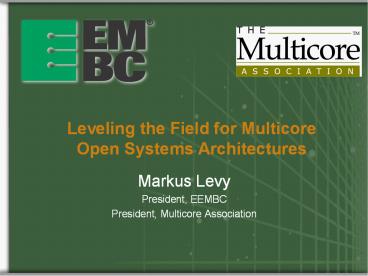Leveling the Field for Multicore Open Systems Architectures - PowerPoint PPT Presentation
1 / 22
Title:
Leveling the Field for Multicore Open Systems Architectures
Description:
Dual Quads vs. Single Quad. Find max values for each workload ... Dual Quad Cores. Dual Memory Controllers. The Multicore Association Roadmap. Communications ... – PowerPoint PPT presentation
Number of Views:134
Avg rating:3.0/5.0
Title: Leveling the Field for Multicore Open Systems Architectures
1
Leveling the Field for Multicore Open Systems
Architectures
- Markus Levy
- President, EEMBC
- President, Multicore Association
2
Analyzing the Multicore Ecosystem
- Embedded Microprocessor Benchmark Consortium
(EEMBC) - Industry benchmarks since 1997
- Tool for evaluating embedded processors,
compilers, systems - MultiBench for shredding multicore processors
3
Enabling the Multicore Ecosystem
- Initial engagement began in May 2005
- Industry-wide participation
- Current efforts
- Communications APIs
- Hypervisors
- Multicore Programming Practices
- Resource Management
4
Multicore Issues to Solve
- Concurrent programming
- Communications, synchronization, resource
management between/among cores - Performance analysis
- Debugging
- Distributed power management
- OS virtualization
- Modeling and simulation
- Load balancing
- Algorithm partitioning
5
Multicore Benchmarking Rules
- Do not rely on a single answer
- Match your application requirements
- Small or large data sets
- Few or many threads
- Dependencies
- OS overhead
6
Benchmarking Multicore Whats Important?
- Measuring scalability
- Memory and I/O bandwidth
- Inter-core communications
- OS scheduling support
- Efficiency of synchronization
- System-level functionality
7
EEMBC Multicore Strategy
- Evaluation and future development of scalable SMP
architectures - Includes multicore and manycore
- Measure impact of parallelization and scalability
across both data processing and
computationally-intensive tasks
8
Some Results
MultiBench Results
9
Two Processor System Utilizing Single Memory
Controller
Quad Core Processor 1
Quad Core Processor 2
Intel Front Side Bus
DDR2 FB DIMM Memory
North Bridge
DDR2 Interface
Processors 1 and 2 must always arbitrate for
memory via their front side bus connection
through the North Bridge.
10
Dual Quads vs. Single Quad
No Workloads Yield 2x Scaling
- Find max values for each workload
- Ratio of all scores
11
Two Processor System Utilizing Dual Memory
Controllers
DDR2 ECC Registered Memory
DDR2 ECC Registered Memory
Quad Core Processor 1
Quad Core Processor 2
DDR2 Interface
Link
DDR2 Interface
Direct Access Shared Access Doubly Shared Access
12
Two Processor System Utilizing Single Memory
Controller
DDR2 ECC Registered Memory
Quad Core Processor 1
Quad Core Processor 2
Link
DDR2 Interface
- Processor 1 must always access memory by
traversing link to Processor 2 - Requires arbitration to access Processor 2s
memory - Processor 2 always has prioritized access to this
memory since it is directly attached. - Affinity can help performance
13
Dual Quad Cores Dual Memory Controllers
Dual Quad Cores Single Memory Controller
14
- Rotation by multiple workers cooperating to
process a single image. - Each worker thread acquires slices and writes
them to the output buffer. - Potential bottlenecks related to memory
interfaces and synchronization between worker
threads.
15
Dual Quad Cores Dual Memory Controllers
Dual Quad Cores Single Memory Controller
16
The Multicore Association Roadmap
The Four MCA Pillars
- Communications
- MCAPI ultra-light weight
- Resource Management
- Memory management
- Basic synchronization
- Resource registration
- Resource partitioning
- Task Management
- Task scheduling
17
Why Virtualize?
- Hardware consolidation
- Migration and hosting of legacy applications
- Resource management and balancing
- Faster provisioning
- Fault tolerance
18
Virtualized Multicore System
CORE 3
CORE 4
CORE 1
CORE 2
- Fractional CPU assignment for background tasks
such as firmware update/system health
monitor/power management - Benchmarking involves many system-level elements
19
EEMBC HypermarkImportant Metrics
- Overall performance overhead of a hypervisor,
i.e. CPU loading - Static footprint (code and data size)
- Jitter
- Interrupt latency
- Comparison to native performance
20
Multicore Programming Practices(MPP)
- Long term
- Continue research into languages, methodologies,
etc - Short term
- How todays embedded C/C code may be written to
be multicore ready - Influence of a group of like-minded methodology
experts to ensure completeness, usefulness and
industry-wide compatibility - Creation of a standard best practices guide
through a recognized, neutral industry body - Based on capturing current best practices
20
21
MPP Scope Approach
- Focus on existing C/C without extensions,
targeting current architectures - Draw up framework of common pitfalls when
transitioning from serial to parallel - Consider solutions or avoidance tactics
- Analyze performance of solution
Sequential C/C
Architecture 1 e.g. Shared Memory
Architecture 2 e.g. Programmer Managed Memory
Architecture 3 e.g. Message Passing
21
22
Summary
- Performance analysis highlights benefits and
pitfalls - EEMBC licensing and membership
- Portability prevents entrapment
- Multicore Association standards and working groups

